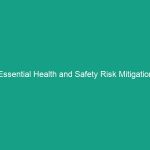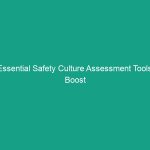Good morning team!
Today, we’re addressing a critical and sensitive topic that impacts many individuals and our workplace as a whole: Essential Guidelines to Prevent Workplace Suicides. Our objective is to cultivate a safe and supportive Environment for everyone. Understanding how to recognize and address the signs of mental distress is vital for ensuring not only our Safety but also our collective well-being.
Understanding Essential Guidelines to Prevent Workplace Suicides
When we talk about preventing workplace suicides, we refer to the strategies and practices that help identify and support employees who may be struggling with mental health issues. This is crucial because mental health directly influences not only personal well-being but also productivity and morale within our teams.
Many people mistakenly believe that discussing mental health or suicide Prevention is taboo, or that it doesn’t affect them. However, it is essential to recognize that mental health issues can impact anyone, regardless of their role or background. By understanding this, we can foster an open dialogue and support system that can save lives.
Key Hazards, Risks, and Safety Considerations
Ignoring mental health in the workplace can lead to severe consequences, not just for the individual but for the entire team. Here are some key risks associated with neglecting mental health:
- Increased absenteeism: Employees dealing with mental health issues often take more sick days, which can disrupt workflow and team dynamics.
- Decreased productivity: Mental distress can lead to lower output and lack of engagement in work tasks.
- Workplace conflicts: Stress can exacerbate interpersonal issues, leading to conflicts and a toxic work environment.
- Increased turnover: Employees may leave an organization where they feel unsupported, resulting in loss of talent and increased recruitment costs.
Best Practices, Procedures, & Actionable Advice
To effectively prevent workplace suicides, it’s essential to implement Best Practices that everyone can embrace. Here are some strategies to consider:
1. Foster Open Communication
Encourage an environment where employees feel safe to discuss their mental health. Regularly check in with team members and create informal settings where they can share their concerns without judgment.
2. Provide Training and Resources
Invest in mental health training for all employees. This could include workshops on stress management, resilience, and recognizing the signs of mental distress in oneself and others. Providing resources, such as access to counseling services, can also be invaluable.
3. Establish a Supportive Work Culture
Build a culture that prioritizes mental health by implementing policies that promote work-life balance. Encourage breaks, flexible work hours, and mental health days without stigma.
4. Implement Peer Support Programs
Develop peer support programs that allow employees to connect with trained colleagues who can provide support and guidance. This creates a safety net of understanding and encouragement within the workplace.
5. Recognize the Signs
Be aware of the signs that someone may be struggling with their mental health. This includes changes in behavior, withdrawal from social interactions, or a noticeable decline in work performance. If you notice these signs, approach the individual with empathy and support.
Regulations, Standards, and Compliance
It’s important to be aware of Regulations and Standards concerning workplace mental health. Compliance with OSHA guidelines and other relevant mental health policies is critical. By adhering to these standards, we not only protect our employees but also create a healthier work environment.
Additionally, our organization has specific policies in place to support mental health initiatives. Familiarizing yourself with these can empower you to utilize available resources and support systems effectively.
Employee Engagement & Discussion
Let’s take a moment to discuss this further. What safety challenges have you encountered related to mental health in the workplace? How can we improve our current practices? Your insights are invaluable in shaping a supportive work environment.
Conclusion & Key Takeaways
In conclusion, preventing workplace suicides is a shared responsibility that requires awareness, communication, and action from all of us. By fostering a supportive culture, recognizing the signs of mental distress, and implementing effective practices, we can create a safe environment for everyone.
Remember, prioritizing mental health is not just about compliance; it’s about caring for each other as colleagues and friends. Thank you for your attention and commitment to making our workplace a safer and more supportive space for all.


